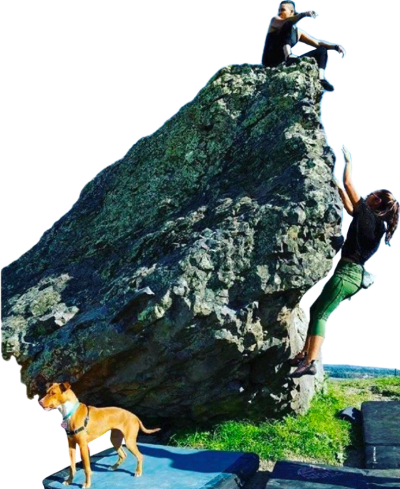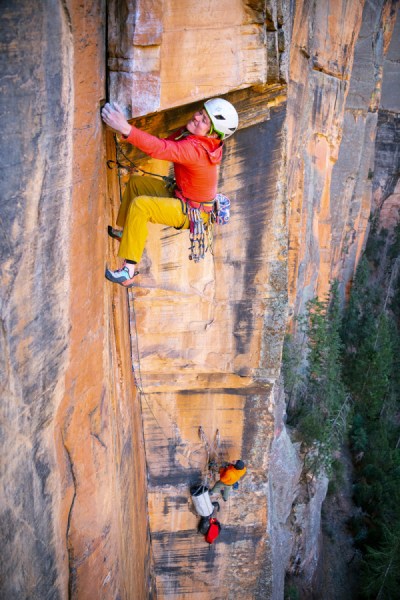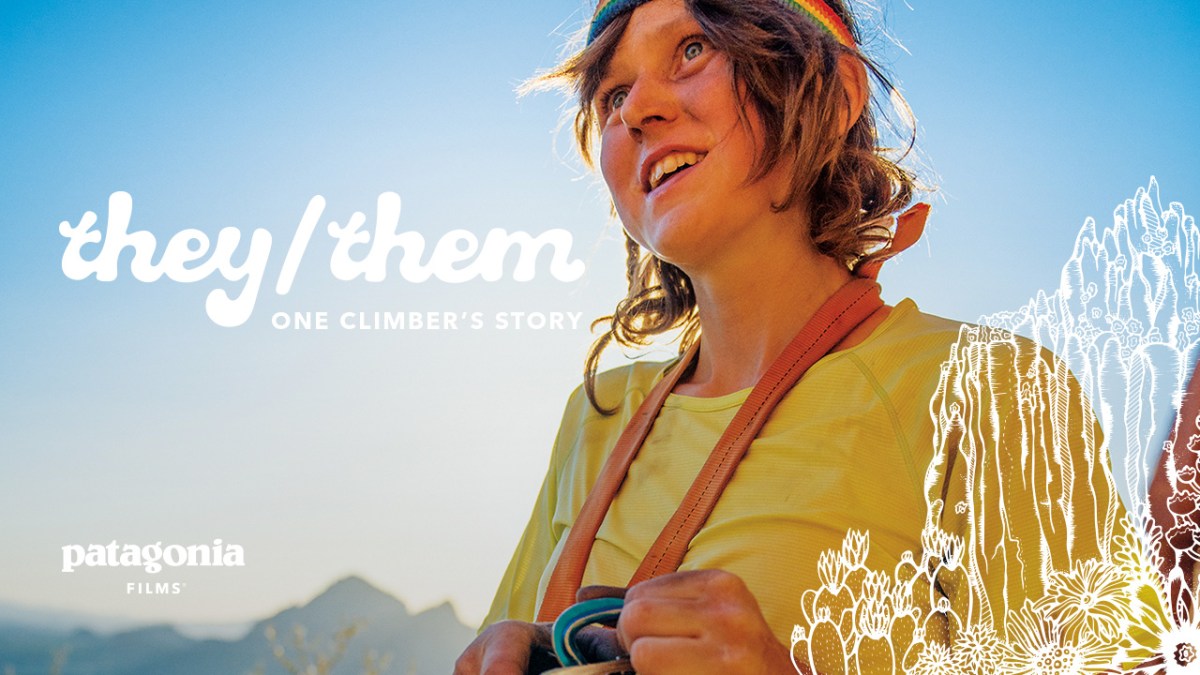This post is sponsored by Patagonia.
Mere hours after I spoke to Lor Sabourin, a non-binary climber, educator, mental health coach and the subject of Patagonia’s new film They/Them, I was on my way to Yosemite National Park to do some bouldering. But halfway through the drive, I realized I’d forgotten my crash pad.
In my opinion, a crash pad – the 4 inch thick foam pad an outdoor boulderer sets on the ground to break their fall – is essential. I had two options: give up or somehow find a boulder, among the dozens in Yosemite, that other people were already climbing – and ask them if I can join their session.
During our conversation, Lor mentioned how supportive the climbing community can be. Despite its sometimes-appropriate stereotype as a bastion of muscly, grunting, macho types, this also mirrors my experience in climbing gyms – tempered, however, by my being trans.
But the outdoors is a space, they elaborated, that allows one to feel neutral about one’s body in a uniquely liberating way. Bouldering can be done alone, which is why it’s my preferred climbing style — but without a crash pad, I couldn’t go it alone. I had to interact with other people. And for trans people that’s never neutral.

Abeni (seated at top of boulder) enjoys the view on a QTPOC climbing trip
Facing risk and fear is essential to climbing; in fact, it’s one of the main appeals of the endeavor. Doing the same is also near-universal to the trans experience, Lor explained, and climbing explores this internal drama externally. How do we manage risk while climbing, while living? Stay on the ground? Close ourselves off to strangers to prevent rejection? Or step out of our comfort zones despite the potential danger?
I walked alone to a well-known boulder near Tuolumne Meadow, and by chance found a group of climbers sessioning it. They welcomed me with open arms, and we had a blast — my first time ever climbing with strangers.
Lor and I spoke about how climbing has empowered them to love themselves and open themselves to the support of strangers, how the outdoor industry is shifting toward increased inclusion, and why the film tracks their journey toward sending their most challenging route ever.
Abeni: Why climbing? You started when you were young; what attracted you to it?
Lor: I started when I was 12. Like it is for a lot of trans folks, those early teenage years were a really high-conflict time internally. I was struggling socially. I played a ton of sports, but I never felt super connected to the communities that I played those sports with. And then I tried climbing!
I just really loved the way that people talked about their climbing and the way they were treating each other at the gym. Climbing was something that I got to approach on my own. Achievement in climbing was a little bit ambiguous. So all of those things just made it like a really safe place for me.
My very favorite style of climbing is crack climbing. It’s like solving a puzzle – how you’re going to fit your body into the crack and work around it. I really like that part of it. And I like the places that it brings me to. I’m really drawn to the aesthetics of cracks and I’m really drawn to like the physicality and the puzzle-solving aspect.
I love bouldering because of that puzzle-solving aspect. I’m solving a puzzle with my mind, but I’m doing it with my body. It feels like the most embodied thing that I do. Is that part of the appeal of climbing to you as a trans person?
Oh, totally. I’ve had a couple of times when I’ve gotten to teach entire clinics of queer climbers. And I’ll say something about how we’re doing this to try to develop trust in our bodies and to learn to see our bodies as safe places. And there’s just, the head nods of everyone, like, yes, that’s a huge reason we’re climbing.
I had to learn to feel safe enough in my body that I was able to go rock climbing. And then climbing made my body feel like a safer place, and kind of taught me to take care of it.
In the film They/Them, you connect climbing to self-care.
I learned from a young age to feel really afraid of my body, and really hate it in a way. At best I felt really apathetic about its well-being. And at worst I felt really self-destructive. I took so much of other people’s pain and confusion about my identity out on my own body. It wouldn’t have been OK for me to take it out on them, but somehow it felt okay for me to respond with anger to my own body.
And people say “nature doesn’t discriminate.” I think what they’re trying to say is, nature is a very neutral space. And for me to just allow my body to exist in a neutral space – that has been very healing for me. It makes me believe that’s a possible way to interact with my body more often.
Recently, a lot of companies like Patagonia and REI are making moves around being more inclusive of trans people and people of color in the outdoors. And that’s the intention of this film, to a degree, right?
Yeah. I made this film with my friend Blake, and he and I talked in the beginning about how athlete stories are often safer ways for people to experience human stories. And so there’s kind of two audiences for the film. People love athlete stories to understand the human experience, because it kind of exaggerates some of those aspects of being human in athletics, or athletics exaggerates some of those aspects of being human – like dealing with stress and experiencing complex emotions – but it does it in a presentable way.
And we kind of take out some of those popular debates that exist about trans athletes. Because in the film, we really intentionally didn’t talk about the difficulty of the climb, partly just so that we wouldn’t get this conversation around whether my agenda impacted my performance. It was more like, this is a climb that’s hard for me. This is about my story as an athlete. And the other side of that representation is, we were talking about the idea of being able to be embodied, and feeling more neutral towards your body, if not even, having euphoria in your body when you’re outside. And those moments where you feel so connected; like, “I’m so amazing.”
It’s showing folks who are struggling to find a neutral space that the outdoors could be that, and showing them just one example of someone doing that. I don’t know that it’s like, OK, you need to have the same experience. But it kind of just presents the possibility that there is a neutral space. And I definitely remember times in my life when I didn’t believe that was a thing that existed.
I do a lot of crisis work. And in a crisis, if someone has one reference point to feel like, “I can feel neutral in my body again,” that is a super important thing for someone to know. And so if there is a message for the community, it’s just wanting to show a lot of joy, and present that there can be a neutral space to feel connected to your body.
When I first started, the climbing gym felt like a very masculine, hetero, unwelcoming space. But lately, it’s felt like this is changing. Does that mirror your experience?
I do think it’s changing, especially in certain pockets. And the biggest difference is that, several years ago, there were no pockets. When I was growing up, it was exceptional to see a woman doing it. There are definitely still times that I don’t feel safe, but also I can find community and specifically can find safe spaces in climbing pretty readily.
How has finding community both in and outside of the climbing world affected your climbing, and your life?
Because of early messages, maybe that I got at home or from the climbing community, I was like, “Oh, I love these people – but if they knew who I was, they wouldn’t love me. So I need to be really careful.” But what has really blown me away has been the people that I 100% didn’t expect to kind of jump in the arena and learn with me, who have shown me the most unconditional love.
I’ve had climbing partners that were definitely part of that kind of “old guard” of climbers, that really macho culture. And when I came out to them, they just showed me so much unconditional love, and did their own education to be able to support me. And I never, as a kid, could have imagined that I would have people in my life that did that.
I didn’t realize I had that much access to support. And that’s been amazing for my climbing: feeling like I have a safety net under me to try new things and do things that scare me.
I think it’s common, especially among trans people, to do a lot of hypervigilant, premature, closed-off-edness in order to protect ourselves when we anticipate we will be rejected. And then it’s only later we find out, “Oh, actually, these people totally would have been supportive.” And you have to put yourself out there in order to discover that that’s true.
 I spent the first 10 years of my climbing career – just like, every time I pulled off the ground – I was so terrified. I just would seize up. And I almost quit climbing because of it. There was a point where I had a climbing mentor, and it was at a time when I was learning a lot about fear and investigating my relationship with it. And they were just like, “is that what you want out of climbing?”
I spent the first 10 years of my climbing career – just like, every time I pulled off the ground – I was so terrified. I just would seize up. And I almost quit climbing because of it. There was a point where I had a climbing mentor, and it was at a time when I was learning a lot about fear and investigating my relationship with it. And they were just like, “is that what you want out of climbing?”
I was thinking about how for a lot of trans people – well, for me – there was a long time where every time I went out and interacted, I expected to get hurt. And I had to convince myself that, actually, everyone in the grocery store probably wants to buy groceries, not hurt me.
But how do we build the resources to believe that’s true when, just like in climbing, there is real physical danger and you can get hurt? It’s not stupid to think that way, but it’s also impossible to live a happy, fulfilled life when you’re hypervigilant all the time.
You have to navigate risk and fear in order to be a successful, happy climber, and that mirrors how we have to navigate fear and risk just to exist and to move through the world and achieve our goals. In the film, you have a major goal: send this big climb. But you’re against the clock – it’s going to snow soon, and then the climbing season will be over. What is the appeal of sending a really challenging climb?
What setting a goal like that means to me is like, when I first tried it, it felt impossible. And so then I knew that in order to do it, I was going to have to change in order to complete the route. And so it’s embarking really intentionally, and it’s a learning process of allowing a route to change you.
And you choose that challenge. It’s a really powerful experience to choose to change and to allow yourself to learn and to know it’s going to be hard. And you know this from bouldering too; it’s like when you first pick a problem, you have no idea how to do it – and then you start to unlock it. If it’s a really big project, sometimes you unlock really big parts of learning.
You’re embarking on a learning process, but you also know that it doesn’t have to be a learning process that is so painful. It can bring up painful things, but so often in life a learning process is kind of brutal. And with climbing, you get to learn, but it’s mostly fun.
Part of the appeal of that is that the stakes are low. You send the route or you don’t.
Yeah. You get to learn, but it’s kind of – it’s like learning to fall. You’re taking small steps. But as a trans person that has to go out in the world, what does “small steps” even mean, you know? So in climbing, it’s this really neutral, fun learning space. A lot of us have that as kids – we go out and play and learn, but I don’t know that we always have it as adults. So to me, one of the reasons it feels like self-care is because it’s this playful learning opportunity.
Join us for the film premiere of They/Them!
After the premiere there’ll be a panel discussion, hosted by friend of Autostraddle Nikki Smith, with Lor and the filmmakers on October 6, 2021 at 5pm PDT.
RSVP for the Event!


This made me miss my brief adventures in climbing with a queer group that would meet up in and around Boston. I may need to build up some upper body strength and get back into it—I loved bouldering even as I cursed my too-short arms
Do it! I took two years off because of injury and just started climbing again a few months ago. You don’t have to build up your strength first — just get into the gym and build it up by climbing! :)
(also you arms are surely the perfect length)
Queer&Trans climbing stories are just what I am here for! Lor’s words are so insightful – I will definitely be carrying them with me into my next trip to the gym!
<3
Lovely!
So much good stuff to unpack and think about. This quote really hit me.
Thank you for this, always great to read stories about trans & queer people in nature sports like this.
I had something of a similar experience as a motorcycle rider who did camping road trips on my bike – it was a lot of stepping out of my comfort zone.
My little sib is my hero <3 Love this piece so much. It's beautifully done!
Thanks so much for this interview! Truly what I needed to read at this moment <3